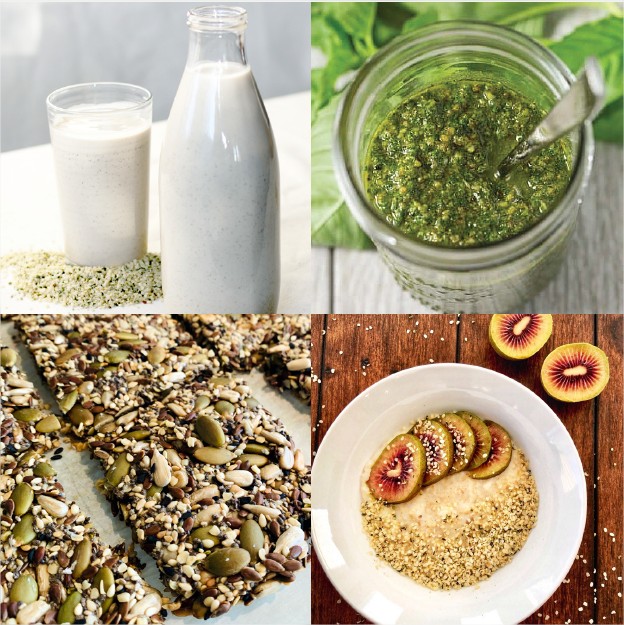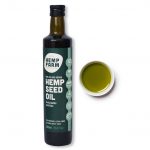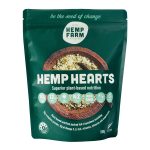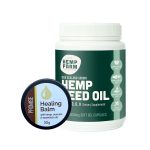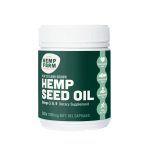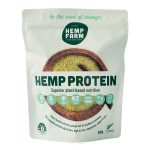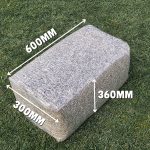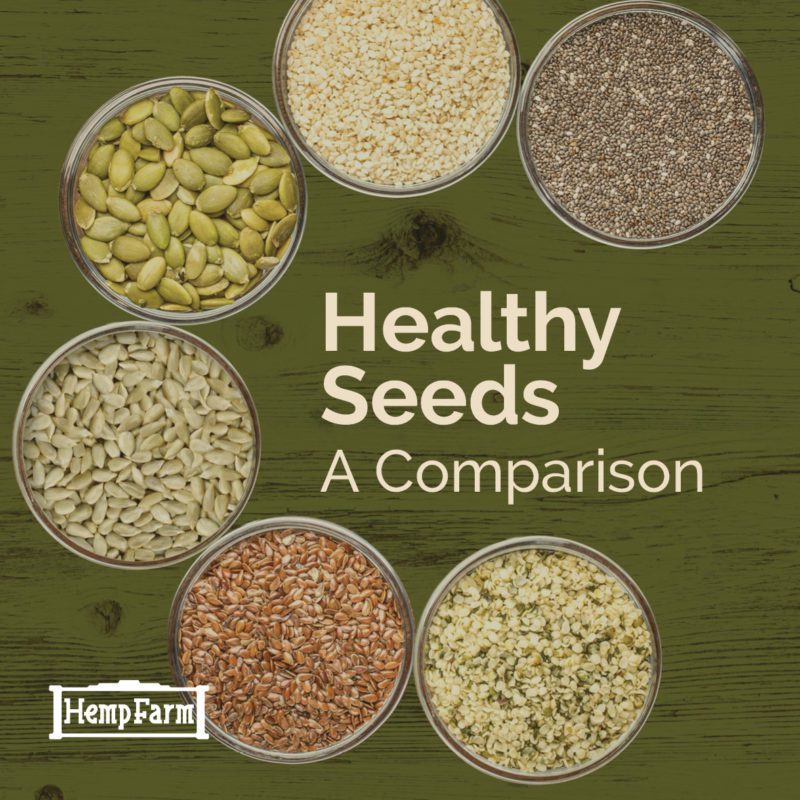
Healthy Seeds Comparison
We want to share with you a Nutritional Seeds Comparison between Pumpkin, Sesame, Sunflower, Chia, Flax & Hemp
Manganese in seeds – a comparison
Dehulled hemp seeds, or hearts as we like to call them, are delicious and nutritious with a mild, nutty flavour and approximately 50% fat. The fats in hemp seeds are almost entirely polyunsaturated fatty acids (PUFAs) that our bodies can’t make and are essential for consumption in our diet. While omega-6s are common in many vegetable oils, nuts, and seeds, hemp hearts stand out for delivering the ideal balance of omega-6 to omega-3 fatty acids of approximately 3:1. Additionally, they contain a good measure of omega-6 fatty acid gamma-linolenic acid (GLA). Hemp hearts are a great protein source, as more than 30% of their total calories are from high-quality protein.
In previous articles we discovered that a single 30g serving of hemp hearts provides around 50% of our daily magnesium requirement, 27% for zinc, 13% for iron, and around 8% for potassium. Hemp hearts outstrip pumpkin, flax, sunflower, chia, and sesame seeds in almost all these minerals.
How about manganese, and what even is it? Manganese is a trace mineral which your body needs in small amounts. It’s essential for the normal functioning of your brain, nervous system, and many of your body’s enzyme systems. Whilst your body does store some manganese in your kidneys, liver, pancreas, and bones, you also need to get it from your diet. Manganese is found in seeds and whole gains, as well as in smaller amounts in legumes, beans, nuts, leafy greens, and tea.
So how does hemp seed stack up? Well, a single serving of hemp hearts, (equal to 3 tablespoons, or about a quarter of a cup), contains around 2.2mg or 99% of the recommended daily manganese intake.

Why do I need manganese in my diet?
Manganese contributes to our health in some of the following ways, as it…
- Is essential for bone health, including bone development and maintenance. When combined with the nutrients calcium, zinc and copper, manganese supports bone mineral density. This is particularly important in older adults.
- Contributes to the way that antioxidants help protect against free radicals. Free radicals are believed to contribute to aging, heart disease and some cancers.
- May contribute to decreasing inflammation and pain associated with inflammatory diseases and plays a role in regulating blood sugar.
- Helps enlarge veins to carry blood to tissues like the brain. Adequate manganese levels in your body may help increase blood flow and decrease your risk of some health conditions like strokes.
- Is essential for healthy brain function and is often used to help treat specific nervous disorders.
- Is necessary for the normal function of your thyroid gland.
- May help with wound healing by playing a role in collagen formation in skin cells.
How much manganese do I need?
Since manganese is found in many foods, manganese deficiencies are rare. While there is no Recommended Dietary Allowance (RDA) for manganese, the Adequate Intake (AI) recommendation is 1.8–2.3 mg per day.
The tolerable upper intake level is 11 mg per day for adults. Like zinc, copper, selenium and iron, manganese is considered a heavy metal, and consuming too much can potentially be dangerous. A healthy person with functioning liver and kidneys should be able to excrete excess dietary manganese. However, those with liver or kidney disease need to be cautious.
Which foods are rich in manganese?
Some examples of foods that are good sources of manganese include:
- nuts and seeds – HEMP HEARTS!
- beans and legumes
- oatmeal and bran cereals
- whole wheat bread
- brown rice
- leafy green vegetables, such as spinach
- fruits, such as pineapple and acai
- dark chocolate
Zinc in seeds – a comparison
Dehulled hemp seeds, or hearts as we like to call them, are delicious and nutritious with a mild, nutty flavour and approximately 50% fat. They are exceptionally rich in two essential fatty acids, linoleic acid (omega-6), and alpha-linolenic acid (omega-3). Additionally, they contain a good measure of omega-6 fatty acid GLA, (gamma-linolenic acid). Hemp hearts are a great protein source, as more than 30% of their total calories are from high-quality protein.
In previous articles we discovered that a single 30g serving of hemp hearts provides around 50% of our daily magnesium requirement, 13% for iron, and around 8% for potassium. Hemp hearts outstrip pumpkin, flax, sunflower, chia, and sesame seeds in almost all of these minerals.
So let’s look this time at a comparison for zinc. Zinc is another one of those minerals that your body does not produce, meaning it needs to be obtained via food or supplements. Zinc is present in a wide variety of both plant and animal food and is necessary for many processes in your body. After iron, zinc is the second most abundant trace mineral in your body and is present in every cell.
So how does hemp seed stack up? Well, a single serving of hemp hearts, (equal to 3 tablespoons, or about a quarter of a cup), contains around 3mg or 27% of the recommended daily zinc intake, considerably more than the equivalent serving of pumpkin, sesame, sunflower, chia, or flax seed.

Why do I need zinc in my diet?
As we alluded to earlier, zinc is necessary for the activity of over 300 enzymes that aid in metabolism, digestion, and nerve function. It’s critical for the development and function of immune cells and is fundamental to skin health, DNA synthesis and protein production. What’s more, body growth and development rely on zinc because of its role in cell growth and division.
You’ll most likely have heard of zinc supplements in the realm of natural remedies for colds and flu. This is because zinc helps to keep your immune system strong and significantly reduces the risk of infections.
Zinc also effectively reduces inflammation, boosts immune health, reduces your risk of age-related diseases, speeds wound healing and improves acne symptoms.
How much zinc do I need?
The recommended daily intake (RDI) is 11 mg for adult men and 8 mg for adult women. Pregnant and breastfeeding women should consume 11 and 12 mg per day, respectively. Unless you have a medical condition hindering absorption, you should easily reach the RDI for zinc through a normal healthy diet.
To avoid overconsumption, stay away from high-dose zinc supplements unless recommended by a doctor. Ingesting too much zinc can interfere with your absorption of copper and iron.
Which foods are high in zinc?
Many animal and plant foods are naturally rich in zinc, making it easy for most people to consume adequate amounts.
Foods highest in zinc include shellfish, meat, poultry, fish, legumes, nuts and seeds, diary products, eggs, whole grains and some vegetables.
Animal products, such as meat and shellfish, contain high amounts of zinc in a form that your body easily absorbs. Zinc found in plant-based sources like legumes and whole grains is absorbed less efficiently because of other plant compounds that inhibit absorption. While many foods are naturally high in zinc, certain foods such as ready-to-eat breakfast cereals, snack bars and baking flours are fortified with zinc.
Iron in seeds – a comparison
Dehulled hemp seeds, or hearts as we like to call them, are delicious and nutritious with a mild, nutty flavour and approximately 50% fat. They are exceptionally rich in two essential fatty acids, linoleic acid (omega-6), and alpha-linolenic acid (omega-3). Additionally, they contain a good measure of omega-6 fatty acid GLA, (gamma-linolenic acid). Hemp hearts are a great protein source, as more than 30% of their total calories are from high-quality protein.
In previous articles we discovered that a single 30g serving of hemp hearts provides around 50% of our daily magnesium requirement and around 8% for potassium. Hemp hearts also outstripped pumpkin, flax, sunflower, chia, and sesame seeds for both minerals.
So let’s dig into a comparison for iron. Iron is a mineral that the body needs for growth and development. It’s an essential nutrient, meaning you must get it from food. A single serving of hemp hearts, (equal to 3 tablespoons, or about a quarter of a cup), contains around 2.4mg or 13% of the recommended daily iron intake. More than chia, flax, sunflower, or pumpkin seed.

Why do I need iron in my diet?
Your body uses iron to make hemoglobin, a protein in red blood cells that carries oxygen from the lungs to all parts of the body, and myoglobin, a protein that provides oxygen to muscles. Your body also needs iron to make some hormones. Iron is naturally available in the foods you eat, and there are two main types — heme and nonheme iron.
The term “heme” is derived from a Greek word that loosely translates to “blood.” This type of iron comes from animal protein, such as poultry, fish, and beef. On the other hand, nonheme iron comes from plant sources, including legumes, leafy greens, and nuts. Heme iron is easiest for your body to absorb and is 14–18% bioavailable in mixed diets. Nonheme iron, the iron source in vegetarian diets, has a bioavailability of 5–12%.
How much iron do I need?
The amount of iron you need each day varies according to age and sex. Infants, children, and teens have a broad range of iron needs. The recommended daily intake is around 18 mg. Adult men’s needs are more stable, while women’s fluctuate according to age and whether or not they’re pregnant or nursing. For example, a pregnant woman needs around 27mg of iron per day whereas an adult male requires only around 8mg.
The amount of iron your body absorbs is partly based on how much you have stored. A deficiency can occur if your intake is too low to replace the amount you lose every day. Iron deficiency can cause anemia and lead to symptoms like fatigue. Menstruating women who don’t consume iron-rich foods are at a particularly high risk of deficiency.
Which foods are high in iron?
There are plenty of good food choices to help you meet your daily iron needs. Lean red meat is the best source of easily absorbed haem iron, so try to include it 3-4 times per week. Other meats (chicken, poultry, pork) and fish are also good sources.
Combining haem foods with non-haem foods also increases the absorption of iron. For example, adding lean meat to a salad or sandwich increases the amount of iron absorbed from the bread and salad.
It’s not all about the bananas!
We have more insights to share about the nutritional value of hemp seed. Hemp seeds are delicious and nutritious. Technically a nut, they have a mild, nutty flavour and contain over 30% fat. They are exceptionally rich in two essential fatty acids, linoleic acid (omega-6), and alpha-linolenic acid (omega-3). Additionally, they contain a good measure of omega-6 fatty acid GLA, (gamma-linolenic acid).
You’ve no doubt heard that bananas are a great source of potassium. Good yes, but not the only or best food to help you maintain good potassium levels. A single 30g serving of hemp hearts provides approximately 360mg or around 8% of your daily potassium needs. And for a little perspective, a medium-sized banana contains around 420mg of potassium.
So which foods contain good quantities of potassium?
Potassium-rich food sources include:
- hemp seed (hemp hearts)
- fruits, such as avocados, apricots, bananas, prunes, kiwi, oranges, and pineapples
- vegetables, such as leafy greens, carrots, and sweet potatoes
- coconut water, orange juice
- beans
- lean meats
- whole grains
- nuts and seeds
Potassium found in seeds – a comparison
Potassium in Hemp Hearts – 1200mg/100g = 26 %DV
per 30g serving = 8 %DV

The importance of potassium in our diets
Potassium is a mineral found in the foods we eat. It’s also an electrolyte. Electrolytes assist in a range of bodily functions. These include blood pressure, water balance, muscle contractions, nerve impulses, digestion, heart rhythm, and pH balance. Potassium is the third most abundant mineral in the body. A normal amount of potassium in a typical healthy diet is around 3,500 to 4,500 milligrams per day.
Thousands of years ago, in the days of the hunter-gatherers, potassium was abundant in the human diet, while sodium was scarce. The so-called Paleolithic diet delivered about 16 times more potassium than sodium. Today, most people get barely half of the recommended amount of potassium in their diets. The average Western diet contains about twice as much sodium as potassium, because of the salt hidden in processed foods. This imbalance is thought to be a major contributor to high blood pressure, affecting around one in three adults.
Your body does not produce potassium naturally so it’s super important to include potassium-rich foods in your diet. Consuming too little, or too much potassium can lead to serious health problems. If your potassium levels were to become too high, they may cause an irregular heartbeat or potentially a heart attack. Symptoms of high potassium levels can present as weakness, numbness, and tingling. Fortunately, healthy kidneys maintain normal potassium levels in the body by removing excess amounts through urine.
How can I use hemp hearts in my diet?
Simple really… sprinkle a spoonful or two as a nutty topping on your porridge, cereal, salad, or yoghurt. Or, add into smoothies for a creamy texture. Hemp hearts are also a fantastic addition to vegan burgers, in baking, energy balls, raw brownies, or whizzed up in pesto.
Wherever you would use nuts, you can generally use hemp hearts either on their own or in the mix with other nuts.
In summary, try to eat more fresh produce. Higher potassium consumption from a diet rich in healthy fruits, vegetables, nuts and seeds may lower blood pressure and the risk of heart disease and strokes.
We want to share with you what an absolute nutritional powerhouse hemp seeds are. Technically a nut, hemp seeds are extremely nutritious. They have a mild, nutty flavour and contain over 30% fat. They are exceptionally rich in two essential fatty acids, linoleic acid (omega-6), and alpha-linolenic acid (omega-3).
We recently came across some nutritional comparisons with other nuts and seeds that highlight how much of a punch these amazing little seeds pack.
To be consistent, we have reported the comparison based on 100g of hemp hearts, (the dehulled hemp seed), and how much it would contribute to the daily requirement of that nutrient. This is expressed as %DV, giving an indication as to whether a serving of food is high or low in a nutrient. For example, 5% or less is low, 20% or more is high.
Please note that our recommended serving size for hemp seed is 30g.
Magnesium in Hemp Hearts – 700mg/100g - 167 %DV
(per 30g serving - 50%DV)
So, what’s the deal with magnesium? Why do we need it? What are the benefits of including it in our diets? And how can hempseed contribute to ensuring we are consuming adequate levels of magnesium in our diets.
Magnesium is a mineral that supports hundreds of important body processes, including those that control how your muscles and nerves work. This essential mineral supports strong bones, normal blood sugar levels, a healthy heart, and optimal energy levels. While it is possible to get sufficient magnesium through a healthy diet, the reality is that our modern-day food production and processing methods often leave us lacking. This can lead to a variety of health issues, including type 2 diabetes, high blood pressure, and migraines. Older adults and those with type 2 diabetes or digestive issues are more likely to be deficient, either because their bodies get rid of too much magnesium, or they don’t take in enough the first place. The recommended dietary allowance (RDA) of magnesium for adults is around 420 milligrams (mg) per day.
Benefits of magnesium:
-
Protects against bone loss, broken bones, and osteoporosis
– individuals who consume higher amounts of magnesium have better bone mass density -
Fights inflammation, protects against viruses and helps to heal wounds
– low magnesium intake is linked to chronic inflammation, which is one of the drivers of aging, obesity, and chronic disease -
Helps with healthy heart function
– lowers chances of an irregular heartbeat, heart disease or heart attack
– relaxes the walls of your blood vessels
– helps maintain healthy blood pressure for those with hypertension -
Reduces symptoms of depression in some people
– magnesium plays a critical role in brain function and mood, and low levels are linked to an increased risk of depression -
Decreases the risk of migraines
– significant research has shown that people who suffer with migraines often have low levels of magnesium. One study found that regular intake of magnesium significantly reduced the frequency of migraine attacks. Other research has shown that taking daily magnesium supplements can be effective at preventing menstrual-related migraines. -
Improves PMS Symptoms
– magnesium has been shown to improve mood, reduce water retention and other symptoms in women with PMS -
Lowers the risk of type 2 diabetes and lower blood sugar in some people
– studies suggest that people with type 2 diabetes have low levels of magnesium in their blood, impairing insulin’s ability to keep blood sugar levels under control -
Enhances exercise performance
magnesium helps move blood sugar into your muscles and dispose of lactate, which can build up during
– exercise and cause fatigue -
Improves sleep quality:
– assists with falling asleep, and helping you achieve deep and restful sleep.

And here we are… the wrap up of our brief foray into the mineral content of dehulled hemp seed versus other popular edible seeds. Whilst this was not by any means a comprehensive coverage of the many minerals our body needs and uses; it did provide an indication of just what an amazing superfood hemp seed is.
Minerals are elements that are found in the earth and food and are essential to life. We learned just how essential they are for our wellbeing and for the normal functioning of our brain, nervous system, immune system, bone health, cellular health, and wound healing, to name few benefits. And we learned a bit more about how much of each mineral is necessary for the body to function optimally and which foods provide the highest amounts of these nutrients.
Minerals are divided into two categories based on how much the human body needs. Macro minerals are needed in larger amounts and include calcium, potassium, sodium, chloride, phosphorus, and magnesium. Although equally important, trace minerals including iron, copper, fluoride, selenium, zinc, chromium, molybdenum, iodine, and manganese, are needed in smaller amounts.
We learned that a single 30g serving of hemp hearts provides around 99% of our daily manganese requirement, 50% for magnesium, 27% for zinc, 13% for iron, and around 8% for potassium. Hemp hearts outstripped pumpkin, flax, sunflower, chia, and sesame seeds in almost all of these minerals.
In addition, hemp seeds, or hemp hearts as we like to call them are extremely nutritious. Technically a nut, they have a mild nutty flavour, often compared to pine nuts or sunflower seeds. Hemp hearts contain over 50% fat and are exceptionally rich in two essential fatty acids, linoleic acid (omega-6) and alpha linolenic acid (omega-3). They also contain gamma-linolenic acid, which has been linked to many health benefits. Hemp seeds are a great protein source, as more than 30% of their total calories are from high quality protein.
Brain Food
As the most metabolically active organ in your body, your brain is constantly demanding oxygen and nutrients. In fact, this little organ uses 20 to 40 percent of the nutrients and energy you consume and it’s only 2 percent of your body weight. So even though we need to eat properly to build a strong musculoskeletal system and a healthy cardiovascular system, when we eat, we are primarily feeding our brains. And this is very important because our brain plays a major role in how we see, smell, hear, taste, think, feel, learn, remember, process, and create!
Foods Rich in Minerals
Here are 16 foods that are rich in minerals, and you can probably guess that you won’t find any packaged or ultra-processed food on this list.
- Nuts and Seeds – HEMP HEARTS!!
- Shellfish
- Cruciferous vegetables
- Organ Meats
- Eggs
- Beans
- Cocoa
- Avocados
- Berries
- Yoghurt and cheese
- Sardines
- Spirulina
- Ancient grains
- Starchy vegetables
- Tropical fruits
- Leafy greens
Minerals & Nutrients – wrapping up
In summary, there is no one magic food or nutrient that is special. For our bodies to function at their best we need all of the minerals and vitamins in our blood vessels every minute of every day. Eating a diet of mainly unprocessed foods will provide you with the best chance of obtaining the vitamins and minerals you need for optimal health.
References:
- https://www.healthline.com/nutrition/6-health-benefits-of-hemp-seeds
- https://www.fda.gov/food/new-nutrition-facts-label/how-understand-and-use-nutrition-facts-label
- https://www.webmd.com/diet/ss/slideshow-diet-magnesium
- https://www.healthline.com/nutrition/10-proven-magnesium-benefits#TOC_TITLE_HDR_1
- https://www.healthline.com/health/potassium
- https://www.kidney.org/atoz/content/potassium
- https://www.health.harvard.edu/staying-healthy/the-importance-of-potassium
- https://www.thoughtco.com/potassium-element-facts-606470
- https://www.lenntech.com/periodic/elements/k.htm
- https://www.healthline.com/nutrition/how-much-iron-per-day#importance-of-iron
- https://ods.od.nih.gov/factsheets/Iron-Consumer/
- https://www.medicalnewstoday.com/articles/287228
- https://www.healthline.com/nutrition/how-much-iron-per-day
- https://nutritionfoundation.org.nz/nutrition-facts/minerals/iron
- https://www.healthline.com/nutrition/iron-rich-plant-foods
- https://www.healthline.com/nutrition/zinc
- https://www.healthline.com/nutrition/manganese-benefits
- https://www.healthline.com/nutrition/foods-with-minerals
- https://www.healthnavigator.org.nz/healthy-living/m/minerals/
- https://www.healthline.com/nutrition/6-health-benefits-of-hemp-seeds
- The Better Brain – Bonnie J Kaplan /Julia J Rucklidge



